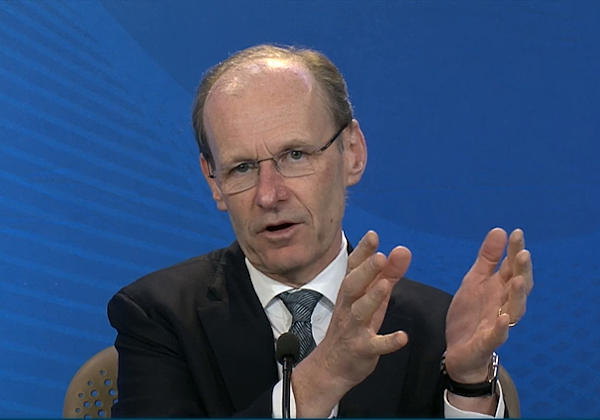
ANZ CEO Shayne Elliott
Investors pummelled ANZ’s share price on Monday after chief executive Shayne Elliott unveiled a lower-than-expected full year cash profit of A$7.41 billion.
While the profit was the largest ever reported by ANZ, analysts said the result fell short of consensus forecasts by around $120 million.
ANZ scrip was sold down heavily during Elliott’s two-hour briefing of investment analysts in the morning when it touched an intraday low of $24.46. The stock price later recovered to close 3 per cent down at $24.70.
High-impact negotiation
masterclass
July 9 & 16, 2025
5:00pm - 8:30pm
This high-impact negotiation masterclass teaches practical strategies to help you succeed in challenging negotiations.
ANZ had been expected to generate fatter earnings through its retail banking operations in Australia after expanding its mortgage book in the 12 months to the end of September 2023 at more than 1.8 times the system growth rate.
However, intense price competition in the home loan market underpinned a sharp contraction in the interest margins of the Australian retail business.
ANZ suffered a 33 basis point reduction in its net interest margin in Australian retail banking, which mostly accounted for the earnings miss on consensus forecasts.
Margin contraction was less extreme across most other parts of the bank, with the institutional and commercial divisions each suffering only 5 basis point declines on NIM.
Elliott sent mixed signals on whether he believed the bank could continue to grow its Australian mortgage volumes in the rising rate environment, but defended the bank’s retention of cashback incentives to home borrowers.
ANZ is the only major bank offering cashbacks to new mortgage customers following decisions earlier this year by CBA, Westpac and NAB to withdraw such incentives.
In his opening presentation to analysts the ANZ chief said he was confident the bank could continue to grow the mortgage book, but he later hedged the commitment.
In response to a question about whether ANZ could sustain the cashbacks and domestic mortgage momentum, Elliott appeared to backtrack.
“I don’t know,” he told analysts in the briefing.
“We don’t target, necessarily, market share growth as the right thing to do.
“We need to be lending responsibly, that’s the first thing.
“We need to be able to do so at a return that is fair and decent for our shareholders.
“The cashbacks - I know there’s been lots of focus and I know it’s fun to write about… but there is a part of the market, understandably, that see that as valuable.”
Elliott defended the continued use of cashbacks, saying that the ANZ’s eligibility requirements for incentive were tight.
Despite his insistence that the bank’s approach to lending was prudent, the cashback appeared to incentivise a greater proportion of high loan-to-value borrowers to the bank in the six months to the end of September.
The proportion of home loan borrowers on LVRs of 90 per cent or greater increased to 6.6 per cent in the second half compared to 4.3 per cent at the end of March.
While several analysts grilled Elliott intensively about the economics of the domestic retail business and provisioning levels, ANZ remains the most recommended of the four major banks by investment analysts mainly because of its comparatively small reliance on home lending as a source of its revenue.
Only one quarter of the bank’s cash profit comes from the Australian retail bank, while ANZ’s internationally focused institutional arm accounts for 40 per cent.
One bank analyst yesterday drew an analogy between Elliott’s strategy in the Australian retail lending market and the price-wrecking approach of a former NAB chief executive, Cameron Clyne.
“It’s about hurting your rivals – NAB, Westpac and particularly CBA – who each have larger mortgage businesses and a greater shared interest in preserving the economics of Australian home lending,” the analyst said.
That sentiment was reflected somewhat more diplomatically in the observations of other senior analysts who believe mortgage-focused banks will be more challenged by worsening economic conditions in 2024.
“I think the composition of ANZ’s result was OK,” said Jefferies senior analyst, Matt Wilson.
“The bank is underweight in retail lending and given the current economic conditions that’s where the pain is going to be felt in 2024.”
Goldman Sachs senior analyst Andrew Lyons told clients in a research report that ANZ would likely continue to compete aggressively in the mortgage market because the bank had more options to grow revenue in other divisions where returns appeared more dependable.
“While it may be argued this strategy will be incremental to ANZ’s shareholder value, we believe it bodes poorly for the extent of any potential recovery in mortgage industry profitability,” Lyons said in the report.
Wilson and Lyons yesterday each reaffirmed their buy recommendations on ANZ.
In response to questions about the declining profitability of the retail business, Elliott said: “Clearly, each of our four divisions has to stand on its own two feet. We believe we have our settings at the appropriate level at the present time”.
Elliott pointed to growth prospects in the institutional business where ANZ is winning a swathe of wholesale mandates from big global banks to process domestic digital payments and currency transactions.
He is also upbeat about the institutional division’s prospects in rapidly growing regional markets such as India and Vietnam.
The institutional division was the star performer in ANZ’s business portfolio throughout 2023 after growing revenue by 26 per cent and cash profit by 53 per cent.
Elliott talked up the bank’s chances of getting its proposed merger with Suncorp Bank over the line at the Australian Competition Tribunal.
Hearings into the merger are due to commence in early December, with a decision expected some time in February.
“We remain confident we will receive approval for the acquisition of Suncorp Bank,” he said.
ANZ directors declared a final dividend of 94 cents per share, partly franked at 53 per cent.